The education and research provider needed to shake up its communications offering to empower staff to better support students
With a website that was struggling to meet the demands of its two distinct audiences – its internal staff, and the external students it serves – Manchester Metropolitan University needed a fresh approach.
The University boasts over 5,300 to 5,700 staff, including sessional staff working within the University seasonally or for short periods of time. Dispersed across 5 faculties and 13 research centers, the staff is responsible for over 38,000 students at any time.
To provide students with the correct support and information, staff need the right tools, knowledge, and connections.
However, internal information and documents were static, growing around departmental structures and often ending up mixed in with student material. With everything living on its external WordPress site, staff faced challenges and frustrations finding what they needed. The University needed a fresh approach.
Intranet Manager Austen Mason takes us through the journey Manchester Metropolitan University took to completely overhaul its internal communications offering, after partnering with Interact in 2018.
Beginning with the end goal in mind

Recognizing where the existing external website was failing to meet staff needs was the first crucial step on Manchester Met University’s intranet journey.
“The University conducted a staff survey about improving communications and engagement, and as part of that, there were three distinct requirements that came to light,” explains Austen.
“Firstly, the need to improve sharing and access to news and updates from the University. The next requirement was around findability of main policies, procedures and important documents; and finally, to provide an enhanced staff directory that could include photos and additional information, beyond just telephone number and job title.”
As a public educator, the University faces continual scrutiny and accountability – alongside a competitive market for both staff and students.
Staff therefore not only need information to ensure they deliver an exceptional experience and service for students, but to also meet a vast range of budgetary, compliance, and institutional demands.
The Interact Excellence Awards Annual 2019
A user-led approach: defining the new intranet structure
After selecting Interact as its partner and recognizing the need to separate out internal and external-based content, Manchester Metropolitan University brought onboard Austen as its dedicated Intranet Manager to oversee the process of migrating and building out the new intranet content, alongside day-to-day management.
Austen and his team opted to place user testing and feedback at the heart of its design approach: getting input from the most critical people in the process, the staff who would be using the new platform.

“We began the process by placing the Treejack article and survey on our existing WordPress site,” says Austen.
“We used this to do some initial testing and get some feedback from staff on the main navigation. During the process we asked staff, ‘if you were looking for this or that, where would you expect to find it?’, testing different types of content.
“The results helped us determine the top navigation, where content should live, how to label it, and the journeys people take to get to what they’re looking for.”
One of the greatest challenges and parts of the project was the process of separating out the different types of content already hosted on the Manchester Met website. What was staff-focused, versus student focused? What content crossed over to serve both audiences? Was it written appropriately for that audience?
“It’s not that we want to hide information from the outside; we are committed to transparency,” explains Austen.
“But it makes it far easier to manage and creates a specific space for staff to find information relating to working at Manchester Met. It’s tailored for an internal audience.
“For example, our HR information is now solely on the intranet, and has been removed from the external website.”
Translating the Manchester Met brand and design vision
The look and feel of an intranet – and the homepage in particular – can have a huge impact on how users engage and connect to their new platform. Getting it right, therefore, is critical.
However, Manchester Met also needed to ensure users were able to ‘pick up and play’ easily and ensure the maximum amount of adoption possible. To ease the transition from to the new intranet, the new design was influenced by Manchester Met’s external brand and website.
“We involved our web team in the design phase and played around with the color schemes featured on our external website to test how the intranet could look, before asking Interact to apply the theme across the intranet,” explains Austen.
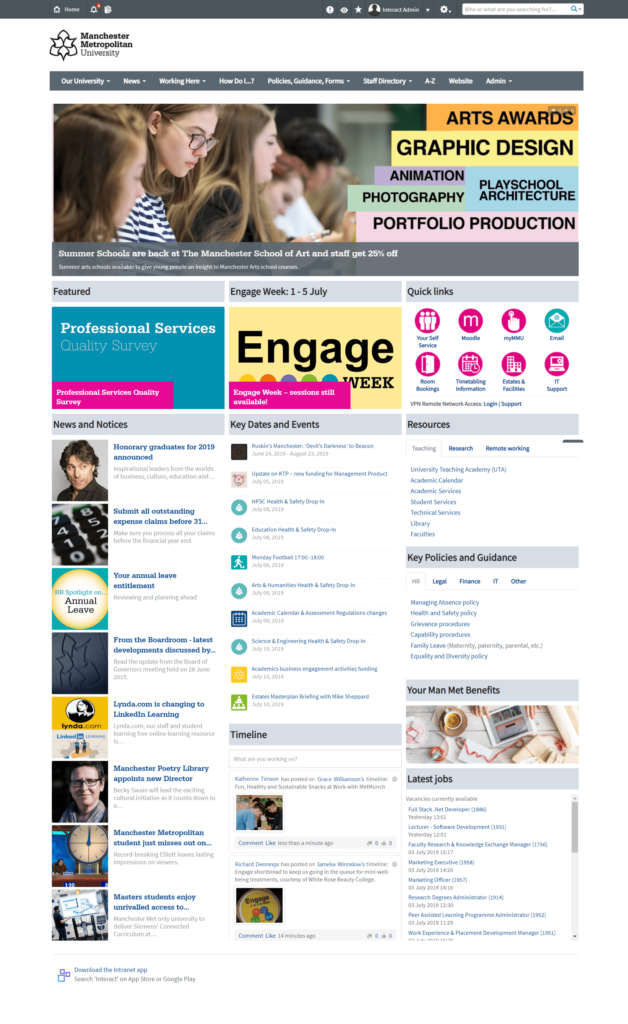
The team also involved stakeholders from Marketing to offer feedback and guidance on the branding to be applied to the intranet, helping to shape the look and feel.
Breaking down siloes: moving away from a departmental structure
The default to a department or team-based approach to organize content and information is surprisingly common.
However, years of experience has shown our in-house team of intranet experts that this doesn’t work for the majority of organizations. In today’s workplaces, fostering connections across the boundaries of department can make a huge difference to the employee experience of work.
Manchester Met understood the value of breaking down those barriers, particularly after the failings of its department-focused structure on its external website. Instead, the team made the decision to adopt an ‘organizational-wide’ structure to its top-level navigation.
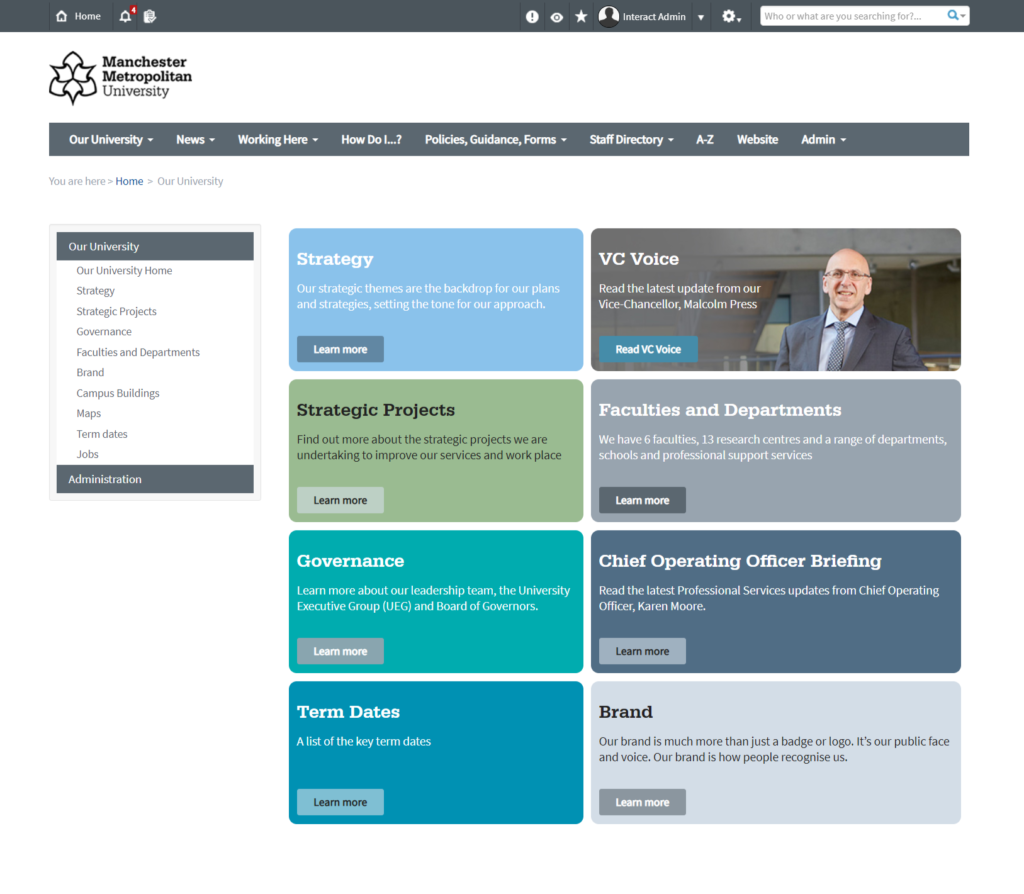
“We have ‘Our University’, which covers the Manchester Met strategy and University-wide projects, along with practical elements like campus building maps and so forth,” says Austen.
“The News area gives staff top-down news that comes into our central team from various locations around the University, providing insights across the different areas or departments.
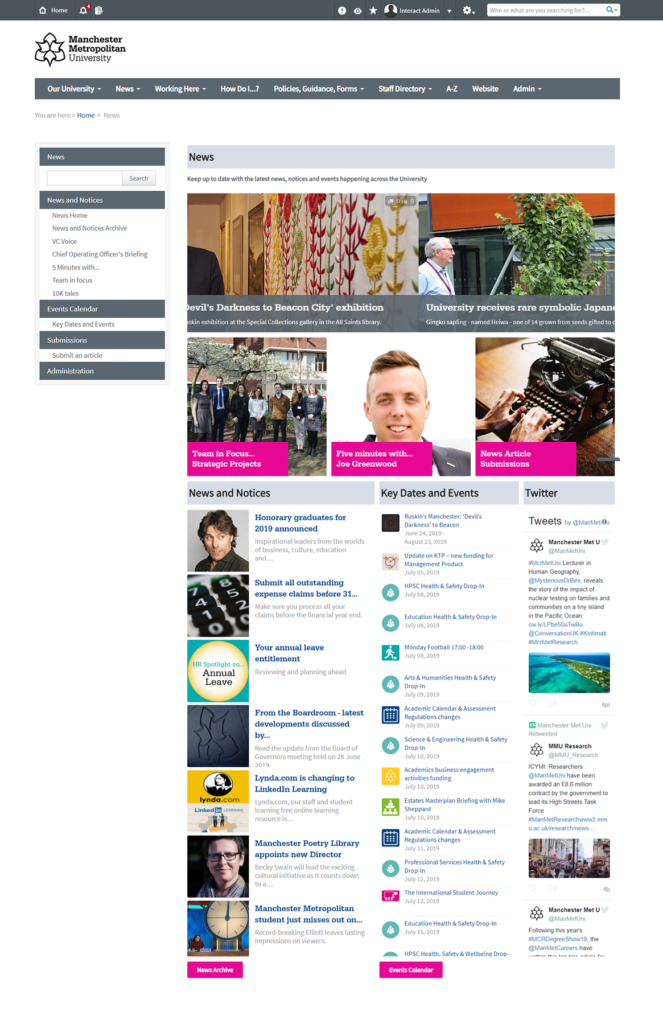
“Then we have ‘Working here’ and ‘How do I?’ which are both more practical elements; policies and guidance or day-to-day support for staff during their life cycle at the University. We include quick pointers to frequently used content or elements, and later we also added an A to Z for frequently accessed content as well.”
The Interact Excellence Awards Annual 2019
Going live: learning on-the-go
An intranet should always be regarded as an organic, evolving process: it’s not something you ‘finish’ and press to go live, only to leave thereafter. It’s a dynamic and living part of an organization.
Austen and his team have taken this mantra to heart, adopting a user-focused and agile approach to continually developing the Manchester Met intranet.
An initial soft launch to just 300-400 staff, including an intranet lead from each different department, enabled the team to get some initial insights and feedback before launching organization-wide. The team was able to respond and adapt as needed.
“Interestingly enough, the requirement for a link to our email web access didn’t come up much during our research and user testing, but when the intranet was switched on for the first time and it wasn’t there, it sparked a reaction,” says Austen.
“Despite the fact that staff can access their email in a number of different ways – through the Outlook app or via web access at home, for example, there were a lot of people who still wanted that quick link from the intranet homepage.
“We had to quickly add it when people started feeding back that they had assumed it would be on there: literally within the first few hours!”
Staggered roll-out of features and functionality
We’re embracing a gradual release of the different elements and building up the intranet slowly and steadily.
Just because a tool can do something, doesn’t necessarily mean that it should from the get-go.
Introducing a platform to staff with all bells and whistles – particularly when it’s a big jump from what they’re used to – can prove detrimental to adoption and engagement. For some organizations, a staggered approach may prove more successful in the long run.
“We identified a fourth and more long-term objective for the intranet, which centered on introducing social elements and collaboration features for staff,” explains Austen.
“We switched on comments and likes within the news section, which we’ve never had before. People are now getting more comfortable with the functionality and we then progressed to introduce the Timeline newsfeed, where staff can post simple updates.
“We’re also seeing our first communities begin to flourish. For example, the Brexit Community is a team site predominately for staff who are non-UK citizens and may be affected by changes coming to the UK. It includes a bit more detailed information but also allows staff to post in forums about things they’ve seen that others may find interesting, or to share their experiences.
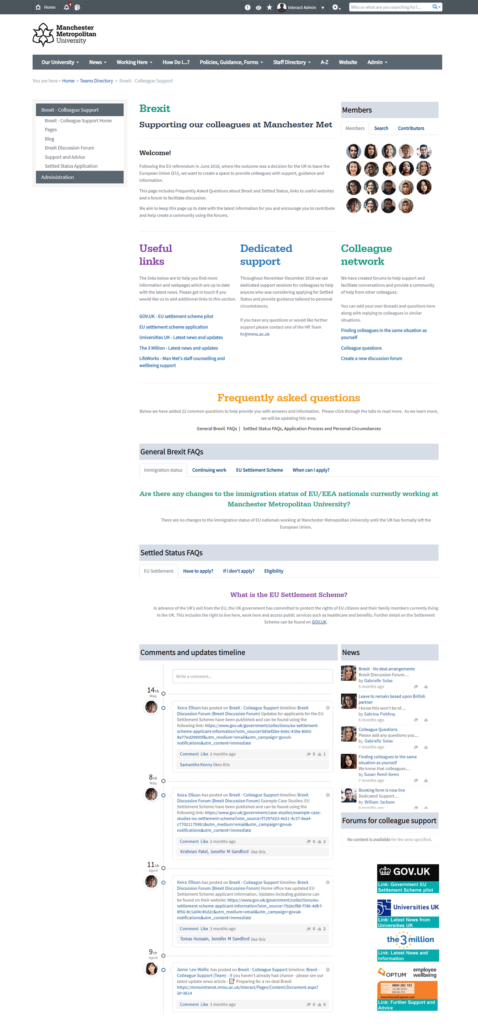
“Ultimately we wanted to ensure we got the main elements right before going onto the next phase, so we’re embracing a gradual release of the different elements and building up the intranet slowly and steadily.”
Adoption and engagement with the Manchester Met intranet
Success looks different for every organization, particularly when it comes to internal projects. Gauging the outcome of the new Manchester Met intranet meant looking back to those original goals and objectives, and delving into the usage analytics to discover those areas that were most widely used by staff.
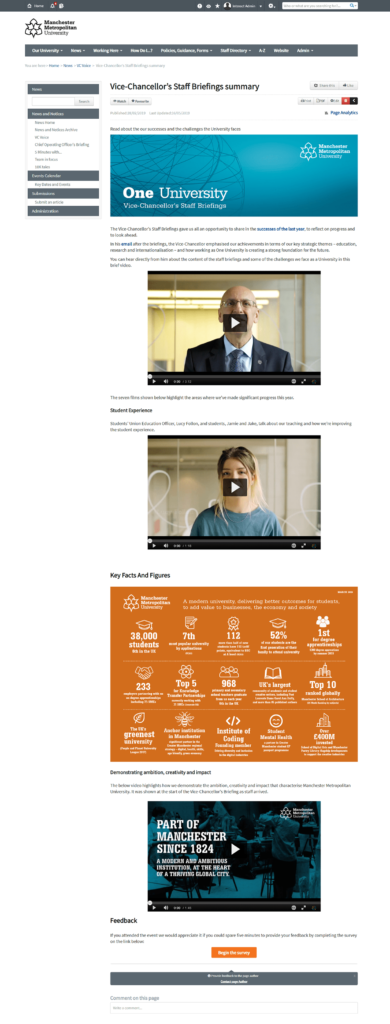
By making the new intranet the default location for internal updates and campaigns, the team has helped foster wide-scale use throughout the University. By example, sign up for the strategic updates – delivered by the Vice Chancellor at the beginning of each calendar year – were managed on the Manchester Met intranet for the first time in 2019, using the calendar function. The seven events were fully booked up by staff on the intranet.
Active users rank at 97% for the Manchester Met intranet, showing the widespread adoption and use of the new platform.
The centralized calendar function is proving useful in other areas also. The University’s Engage Week – consisting of over different 180 events – was also managed on the intranet.
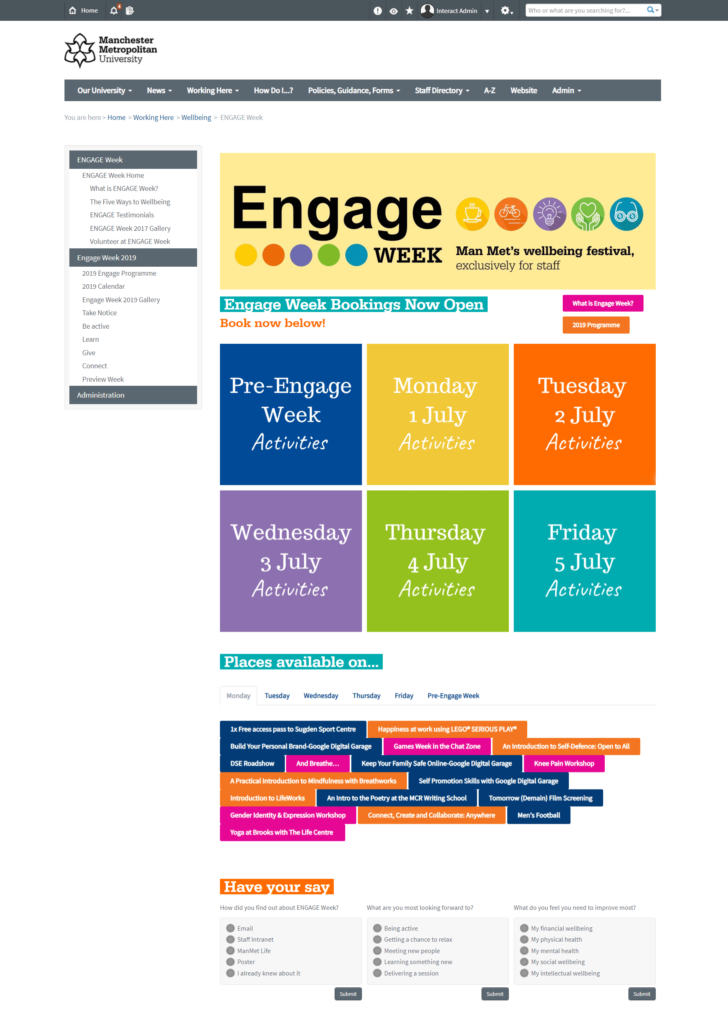
To build anticipation and excitement, a countdown to launch took place on the intranet homepage; within just 15 minutes of going ‘live’, the team saw an unprecedented response of 400 sign-ups to events ranging from archery or Dungeons and Dragons to a talk from Google Drive about online safety.
Over 2,000 spots were booked on the various calendar items in total, making it one of the most successful Engage weeks ever hosted by the University.
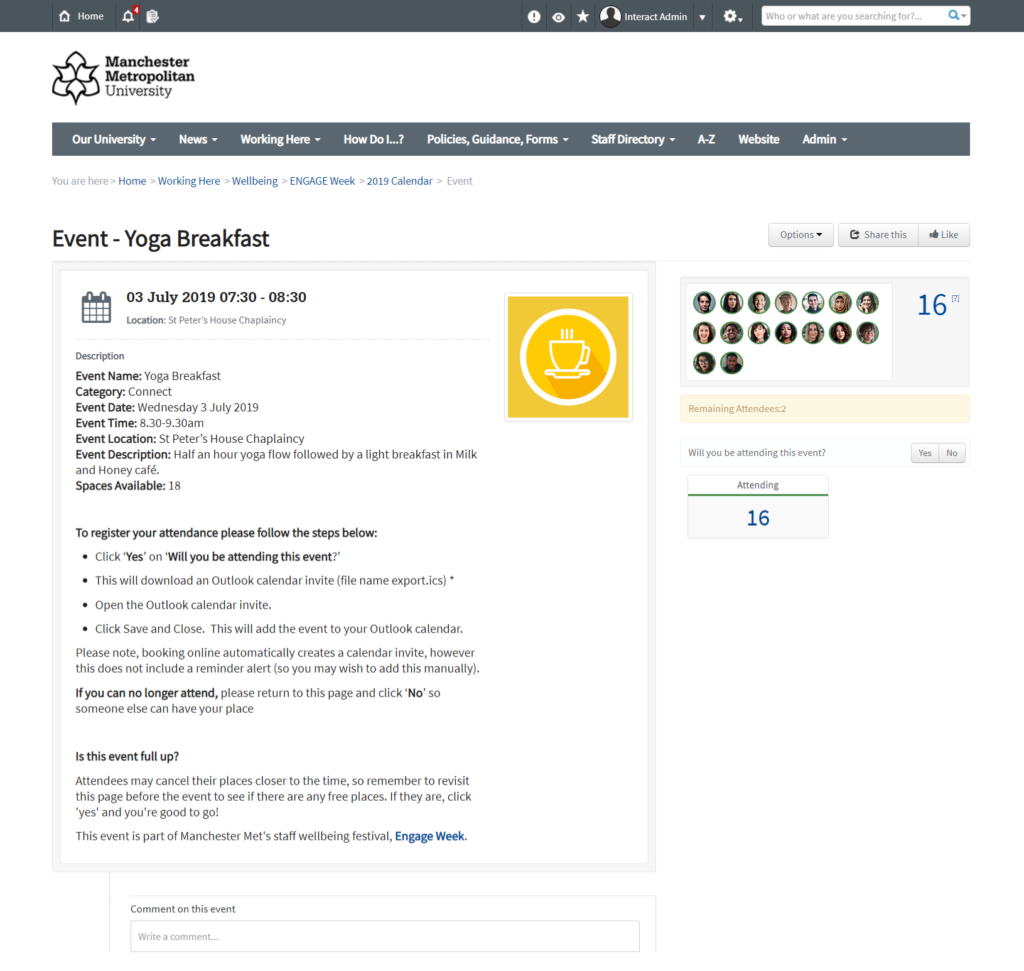
“The calendar has been one of the most useful features for us,” says Austen.
“It’s a central place where any member of staff can see and sign up for events; it’s really simple to use and anytime we have a session, activity or talk running, we can add them quickly and easily.”
Empowering staff, to deliver a better student experience
Thanks to an enhanced People Directory – which goes far beyond name and job title to help staff find each other – alongside the centralized hosting for critical information, staff are better connected and informed than ever before. This enables staff, in turn, to provide a better student experience.
In separating out those two audiences when it comes to communications and tailoring what each receives, the University has transformed engagement and related outcomes.
Perhaps one of the clearest demonstrations of the value of this comes from the University’s annual Internal Student Survey (ISS).
The ISS is used to not only help the University continually learn and improve based on student feedback; it helps to identify potential challenges or issues that need addressing, and feeds into league table results for Manchester Met also. Getting as many students completing the survey as possible is a priority for management.
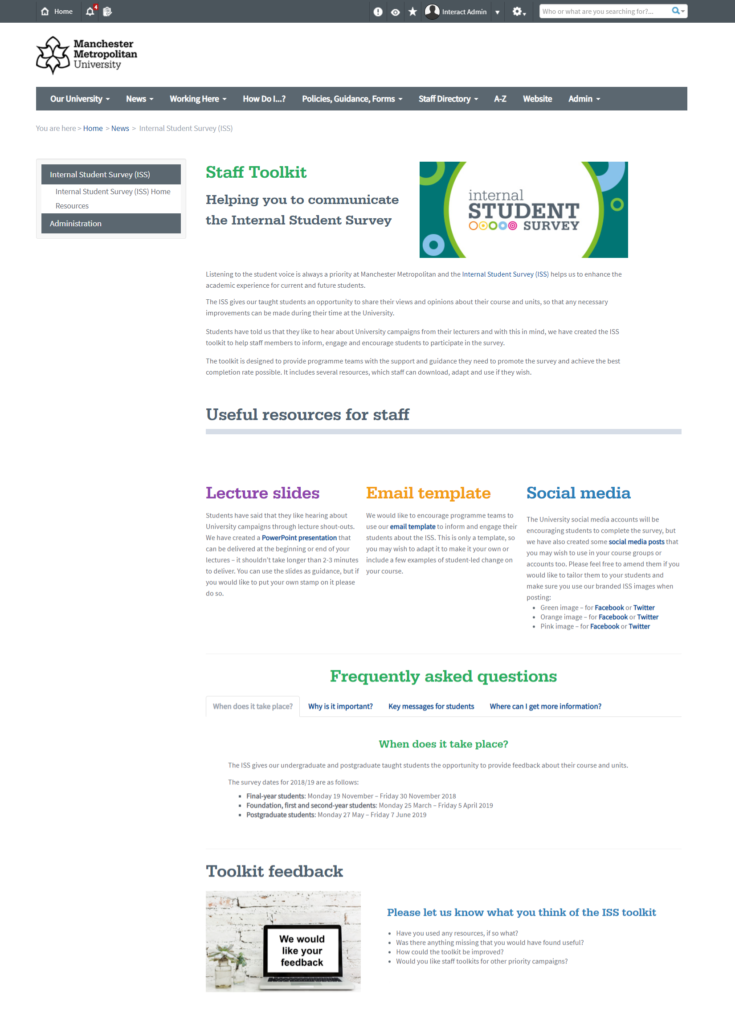
Perhaps the greatest influential impact on participation, however, is staff. Ensuring staff are aware of what and how to get students completing the survey is crucial. To support staff in this process, ‘toolkits’ were created and hosted on the new intranet to provide essential tools, information, and answers to common questions, making it easier than ever for staff to pass that information on.
As a result, Manchester Met saw its highest-ever uptake in the participation of the ISS in 2019.






